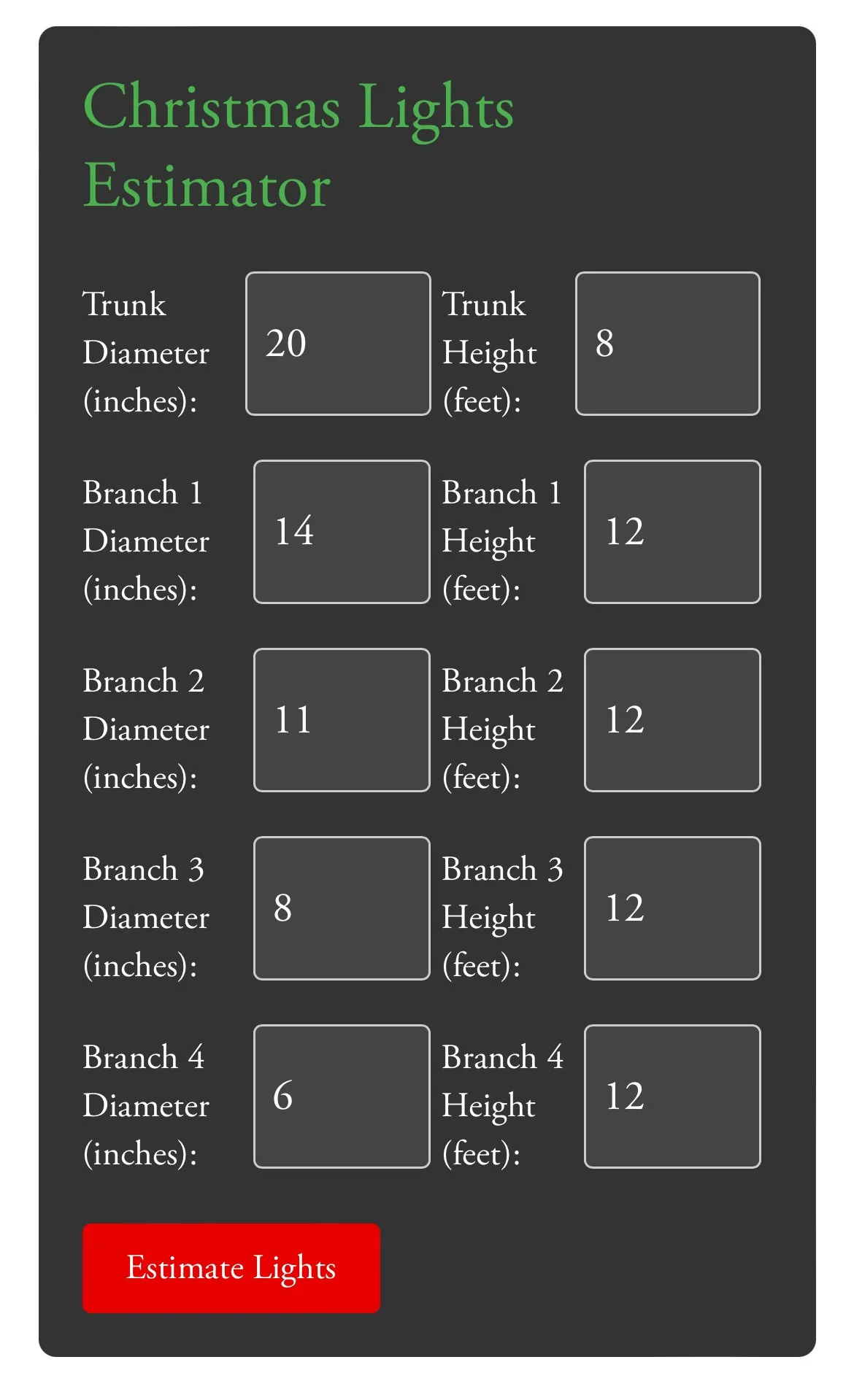Christmas Light Branch Wrapping Estimator - Version 2.0
**We Base Our Christmas Light Tree Calculator using 25 foot long strands**
FAQ: Commercial-Grade LED Mini Lights
1. What types of bulbs are used in your mini light strands?
We use G12 bulbs, mini bulbs, and micro bulbs, all in 25ft lengths. These come in two configurations:
50-count bulbs with 6-inch spacing
70-count bulbs with 4-inch spacing
2. Why don’t you use incandescent lights?
We avoid using incandescent lights due to their high energy consumption. LED lights are more energy-efficient, last longer, stay cooler, and are safer for outdoor use.
3. What makes commercial-grade LED lights better?
Durability: Commercial-grade sets are built to last longer and withstand harsher outdoor conditions.
Brightness: They are generally brighter than retail-grade sets.
Energy Efficiency: They use less energy, which allows you to connect more strands together without overloading circuits.
4. How many strands can I safely connect?
Commercial-grade LED lights allow you to connect many more strands than standard lights. Depending on the manufacturer, you can often connect up to 20-30 strands end-to-end, especially when using low-wattage LEDs.
5. How do I handle trees that require more than 20 strands of lights?
For large trees requiring more than 20 strands, we recommend using several female plug sockets along a custom-cut extension cord (zipline). This allows you to break up the power distribution along the tree and makes troubleshooting easier.
Troubleshooting Guide: Commercial-Grade LED Lights
1. A section of the tree went out, how can I troubleshoot?
Check each strand: By using female plug sockets on the underside of the branches, you can isolate which strand has the issue. This way, only a small section of the tree will go out if a single strand fails.
Inspect the connection points: Ensure that the male-to-female connections between the strands are secure and haven’t been knocked loose.
2. What should I do if an LED strand goes bad?
Recycle or dispose: We recommend throwing away or recycling bad LED strands. Replacing individual LEDs or attempting repairs can be more time-consuming than it’s worth.
3. How can I prevent large parts of the tree from going out due to a single bad strand?
Use multiple female plug sockets: When running lights up the trunk of a tree, add female plug sockets on the underside of branches where you start a new strand. This way, each section of the tree is independently powered, making it easier to troubleshoot and ensuring a single strand failure doesn’t take out the entire tree.
4. My lights are dim or flickering, what should I check?
Voltage drop: If you’ve connected too many strands, even with LEDs, you might experience a voltage drop. Break the connection into smaller groups or use a stronger power source.
Secure the bulbs: Flickering could also indicate loose bulbs, so ensure each bulb is properly seated in its socket.
Tips and Advice for New Christmas Light Installers
1. Use Commercial-Grade LEDs
Invest in commercial-grade LED lights for their durability, energy efficiency, and brightness. They are worth the higher initial cost because they last longer and allow for more strands to be connected.
2. Cut Custom-Length Extension Cords (Ziplines)
For large trees or complex designs, create custom-length extension cords with multiple female plug sockets. This allows for better distribution of power and easier troubleshooting if something goes wrong.
Installation Tip: Run a main cord up the tree trunk and add female plug sockets where branches start to fork. This ensures each section of the tree has its own power source.
3. Secure Installation with Staples and Staple Guns
Use staples wide enough to fit around wire. Dont let new guys do this on large trees. start them on small trees. They are likely to staple the wire or insulating jacket, therefore causing a lot of headache down the road and trashed lights. We use battery powered staple guns
4. Test Everything First
Before installing lights, test each strand to ensure it’s working properly. This saves time and frustration during installation.
5. Organize and Label
Label each extension cord and plug to keep track of which strand powers which part of the display. This will help during setup, takedown, and troubleshooting.
6. Troubleshoot Efficiently
With multiple female plug sockets, if a section goes out, you can quickly isolate the problem to a specific strand without needing to check the entire installation. This method minimizes downtime and makes repairs faster.
7. Use Timers
For efficiency, connect your lights to automatic timers so they turn on and off at set times. This also reduces energy consumption and ensures lights aren’t left on accidentally.
8. Storage Tips
At the end of the season, store lights carefully by winding them up in balls. Start with Female end in hand and wrap it aorund about 5-6 times. After that you can remove from and start wrapping wire around itself into a ball. We like micro lights for this reason, less space taking up by bulb. Wrap end of male cord under a wire and set gently in storage bin.

